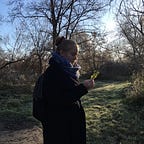Artwork
Place of Place № 1
Intensification of gaze
I have recently taken a series of photographs. They encompass different objects and a multitude of angles. Ultimately, I reached a push towards materiality and colour through this series. Materiality is not encapsulated here as a bare fact. Materiality can be seen as “Here it is” on a superficial level. In my way of thinking, it is not the objects that are important, but their being is important. From this, we proceed to an idea that it is not a documentation. I didn’t intend to save these things.
I’ve been painting by using only black colour, and I have always felt a sophisticated attitude to colour from my side. In retrospect, and it is partly still with me, I was feeling like not interesting things to be in a certain way. If you think about one colour and you use the only one, then it is absolutely necessary as it becomes a part of form, a precondition of image to be.
The photographs are also permeated with an idea of assemblage. This concept speaks to me about going beyond objects per se, but meanwhile including and bound them. It is universal, elusive, but not abstract. Abstraction dwells where there is something that may not be abstract. Such a thing as being placed has only one dimension within itself.
The colour and texture of damp mud as a stage of composition.
Some building material gives the impression of sheets lying on the land.
It employs my thinking of a crucial relationship between the flesh of Jesus Christ and the woodblock of the cross He was hung on. The Crucifixion by Matthias Grunewald is an artwork that can slightly point at it. Roughness makes material what it is by not covering its essence. If the cross is polished, like in many works, it has a particular role rather than initially being a piece of wood. It can be seen through the juxtaposition of this work with The Crucifixion by Gerard David. The tradition of this depiction type came from icons where there is no reason to depict things how they are, which is just another one and equally valuable for us. It can be seen, for instance, in an amazing work by Fra Angelico.
I started by saying about the importance of focus because in order to see these things I abandoned the bird-view that we usually take considering these materials as not valuable. It can be true in a utilitarian sense, as bricks lose their significance when broken because of incapability to use them in building. However, in my series, I am not aiming to make these things valuable either.
All these things shall alter their position and be thrown away. Their significance will remain in their capturing moments. In fact, the act of photography prolongs our gaze. For this reason, we appreciate it, although it can be used just as a tool.
Things can find their meaning in assemblage and placement. Place is a cell for things and doesn’t exist without being placed, i. e. occupied. Place is not space.
In this case, the observer is going to play a role in the act of these things’ perception because I had isolated them from their initial context. Somebody used these materials and saw them in some other way. People from one context, entering a different one, at times have no respect for the novel one, because as human beings they automatically tend to place their values even in a new circumstance. For example, a prominent artwork One and Three Chairs by Joseph Kosuth. This is a chair, but you cannot sit on it, right? Why? Because its role is abandoned. However, for a person looking for a seat, it is a place for it inside of his system.
At the same time it is more than finding something insignificant and paying attention to it that makes a change including shifting contexts of placement; otherwise, it would have been an echo of Marcel Duchamp which is not quite appropriate here.
The truth is small insignificant things are what makes changes in life.
Meanwhile, it is not about value on the one side and not about mechanics on the other.
For the first time I had to tackle technical nuances as the size of photographs was too large and I needed to compress them. Besides this, I am quite content with the result. I would like to show these photographs separately from the text, but in the end if my inner intention is helpful, it is a good thing.
